Note: MCVE at the end
I updated the AppIcon and Document icon for my mac app. The icons have changed but they also show as grayscale. The sources files (PNGs) are colored. The icons appear colored inside Xcode but in context (AppIcon in the dock and Document icons in Finder) are grayscale. I've tried the obvious stuff like cleaning the build folder, relaunching Xcode and relaunching Finder but I don't know what else to try.
This is how the icons appear in context:
This is how the icons appear in Xcode:
All I did was update some PNGs! Everything still functions correctly. The app still launches and double clicking on a document opens the application. The problem is that the icons are gray.
In the git commit that changes the icons, the only things that change are some PNGs and a few documentation files (a link in the README, a screenshot and some other stuff). If I checkout the commit before changing the icons, everything is fine. If I checkout the commit that changes the icons, they're gray.
I've been looking at the PNGs themselves to try to figure this out. I'm using pngcheck to inspect the files.
Old (working) 16x16 icon:
chunk IHDR at offset 0x0000c, length 13
16 x 16 image, 32-bit RGB+alpha, non-interlaced
chunk bKGD at offset 0x00025, length 6
red = 0x00ff, green = 0x00ff, blue = 0x00ff
chunk IDAT at offset 0x00037, length 142
zlib: deflated, 2K window, maximum compression
row filters (0 none, 1 sub, 2 up, 3 avg, 4 paeth):
0 0 0 0 0 0 0 0 0 0 0 0 0 0 0 0 (16 out of 16)
chunk IEND at offset 0x000d1, length 0
New (broken) 16x16 icon:
chunk IHDR at offset 0x0000c, length 13
16 x 16 image, 32-bit RGB+alpha, non-interlaced
chunk IDAT at offset 0x00025, length 109
zlib: deflated, 2K window, default compression
row filters (0 none, 1 sub, 2 up, 3 avg, 4 paeth):
0 1 1 1 2 2 4 1 1 4 2 2 1 1 0 0 (16 out of 16)
chunk IEND at offset 0x0009e, length 0
Ok, so maybe the bKGD chunk is required? Nope. I passed the image through gm convert (with no arguments) which adds the bKGD and also changes the compression level and it's still being displayed in grayscale.
New (broken) 16x16 icon after gm convert:
chunk IHDR at offset 0x0000c, length 13
16 x 16 image, 32-bit RGB+alpha, non-interlaced
chunk bKGD at offset 0x00025, length 6
red = 0x00ff, green = 0x00ff, blue = 0x00ff
chunk IDAT at offset 0x00037, length 106
zlib: deflated, 2K window, maximum compression
row filters (0 none, 1 sub, 2 up, 3 avg, 4 paeth):
0 1 1 1 2 2 4 1 1 4 2 2 1 1 0 0 (16 out of 16)
chunk IEND at offset 0x000ad, length 0
So now it looks like the only difference between the broken PNGs and the working ones are the row filters (and of course the image data itself). WHY ON EARTH WOULD THIS CAUSE A PROBLEM?! I'm not aware of a way to set the row filters using the command line alone. Is this even possible to do with libpng? Whenever I use libpng, I just let the library choose the filters. Would I have to write my own png encoder to solve this?
I feel like I must be barking up the wrong tree here but the only thing that changed (that affects the build) are a handful of PNG files. This is insane.
I played around with this some more and found that the 128@2x icon (not the 256 icon!) is the one that matters. Replacing this image with the old icon causes the old icon to be shown in color. Replacing this image with the new icon cases the new icon to be shown in grayscale. The difference between these two PNG files is what's causing the issue. This is the most ridiculous problem that I've ever encountered.
I'm trying to bring these images closer together to try to make the new one work or the old one break but I just can't figure it out. I passed the old image through the same tool that I used to make the new image (which happens to be the application for which this icon is for!) AND IT STILL SHOWS UP IN COLOR! Here's the pngcheck output.
Old (working) 128x128@2x icon after animera:
chunk IHDR at offset 0x0000c, length 13
256 x 256 image, 32-bit RGB+alpha, non-interlaced
chunk IDAT at offset 0x00025, length 965
zlib: deflated, 32K window, default compression
row filters (0 none, 1 sub, 2 up, 3 avg, 4 paeth):
1 2 2 2 2 2 2 2 0 0 0 0 0 0 0 0 0 0 0 0 0 0 0 0 1
2 2 2 2 2 2 2 1 2 2 2 2 2 2 2 1 2 2 2 2 2 2 2 1 2
2 2 2 2 2 2 2 2 2 2 2 2 2 2 1 2 2 2 2 2 2 2 2 2 2
2 2 2 2 2 2 2 2 2 2 2 2 2 2 2 2 2 2 2 2 2 4 2 2 2
2 2 2 2 1 2 2 2 2 2 2 2 1 2 2 2 2 2 2 2 1 2 2 2 2
2 2 2 4 2 2 2 2 2 2 2 1 2 2 2 2 2 2 2 4 2 2 2 2 2
2 2 4 2 2 2 2 2 2 2 2 2 2 2 2 2 2 2 2 2 2 2 2 2 2
2 2 2 2 2 2 2 2 2 1 2 2 2 2 2 2 2 2 2 2 2 2 2 2 2
1 2 2 2 2 2 2 2 1 2 2 2 2 2 2 2 1 2 2 2 2 2 2 2 0
0 0 0 0 0 0 0 0 0 0 0 0 0 0 0 0 0 0 0 0 0 0 0 0 0
0 0 0 0 0 0 (256 out of 256)
chunk IEND at offset 0x003f6, length 0
New (broken) 128x128@2x icon after animera:
chunk IHDR at offset 0x0000c, length 13
256 x 256 image, 32-bit RGB+alpha, non-interlaced
chunk IDAT at offset 0x00025, length 830
zlib: deflated, 32K window, default compression
row filters (0 none, 1 sub, 2 up, 3 avg, 4 paeth):
0 0 0 0 0 0 0 0 0 0 0 0 0 0 0 0 1 2 2 2 2 2 2 2 2
2 2 2 2 2 2 2 1 2 2 2 2 2 2 2 2 2 2 2 2 2 2 2 1 2
2 2 2 2 2 2 2 2 2 2 2 2 2 2 2 2 2 2 2 2 2 2 2 2 2
2 2 2 2 2 2 2 2 2 2 2 2 2 2 2 2 2 2 2 2 2 4 2 2 2
2 2 2 2 2 2 2 2 2 2 2 2 1 2 2 2 2 2 2 2 2 2 2 2 2
2 2 2 1 2 2 2 2 2 2 2 2 2 2 2 2 2 2 2 4 2 2 2 2 2
2 2 2 2 2 2 2 2 2 2 2 2 2 2 2 2 2 2 2 2 2 2 2 2 2
2 2 2 2 2 2 2 2 2 2 2 2 2 2 2 2 2 1 2 2 2 2 2 2 2
2 2 2 2 2 2 2 2 1 2 2 2 2 2 2 2 2 2 2 2 2 2 2 2 0
0 0 0 0 0 0 0 0 0 0 0 0 0 0 0 0 0 0 0 0 0 0 0 0 0
0 0 0 0 0 0 (256 out of 256)
chunk IEND at offset 0x0036f, length 0
This is ridiculous! I'm beginning to wonder if I've found a very strange bug in macOS.
In case you want to inspect the images yourself, these are the two images from the previous section. I think imgur re-encodes images so I converted them to data URIs so you can paste them into the URL bar and download them.
Old (working) 128x128@2x icon after animera:
data:image/png;base64,iVBORw0KGgoAAAANSUhEUgAAAQAAAAEACAYAAABccqhmAAADxUlEQVR4nO3dQW6kMBRAQRjl/ldmbgALx7KdV7XNIg7debL0DdzPdd3Xi/u6nrefA+f6t3oBwDoCAGECAGECAGECAGECAGECAAAAAAAAAAAAAAAAAAAAAAAbeX0nAOs9h7+X4fYd25onAkGYAECYAECYAECYAECYAECYAECYGe1kp8/xV3OOYC47AAgTAAgTAAgTAAgTAAgTAAgTAAgzYx1kzr+WcwJj7AAgTAAgTAAgTAAgTAAgTAAgTAAgzAz1gzn/2ZwTeGcHAGECAGECAGECAGECAGECAGECAGECAGECAGECAGECAGECAGECAGECAGECAGH5e6Xd799Wf16AHQCECQCECQCECQCECQCECQCECQCECQCECQCECQCECQCECQCECQCECQCECQCECQCECQCECQCECQCECQCECQCECQCECQCECQCECQCECQCECQCECQCECQCECQCECQCE/axewHTP9axewpDj316//eX/WOB9/Cfwxg4AwgQAwgQAwgQAwgQAwgQAwgQAwvafcU6e428/pR41/An/7Ss0/x9g73MEdgAQJgAQJgAQJgAQJgAQJgAQJgAQtn5Gufn9+lsv7jfcf/svXP8F/7L2nIAdAIQJAIQJAIQJAIQJAIQJAIQJAITNn0FuPuf/cvTir+sa/gv2H6S/Onz51+xzAnYAECYAECYAECYAECYAECYAECYAEPazegG7+xrCnn9O4Gznz/nXsgOAMAGAMAGAMAGAMAGAMAGAMAGAsPEx6uH3+882/+IsvvyTB/Hm/F/GnhdgBwBhAgBhAgBhAgBhAgBhAgBhAgBhngcw2egc+/RDFub4e7MDgDABgDABgDABgDABgDABgDABgDDnADZnjs5MdgAQJgAQJgAQJgAQJgAQJgAQJgAQJgAQJgAQJgAQJgAQJgAQJgAQJgAQJgAQJgAQJgAQJgAQJgAQJgAQJgAQJgAQJgAQJgAQJgAQJgAQJgAQJgAQJgAQJgAQJgAQNv/188/1TP8dvBi8/PO/Iby6p34CdgAQJgAQJgAQJgAQJgAQJgAQJgAQJgAQJgAQJgAQJgAQJgAQJgAQJgAQJgAQtv5ub88LWOt2+deae7//FzsACBMACBMACBMACBMACBMACBMACFt/DuCLcwJj7tHP+HH9h6yd83+xA4AwAYAwAYAwAYAwAYAwAYAwAYCwrWeUv+L0cwTDc/zVTj9HsPccf5QdAIQJAIQJAIQJAIQJAIQJAIQJAAAAAAAAAAAAAAAAAAAAAAAAAAAAAAAAAAAAAAAAAAAAvPgPQZExnSU6E9oAAAAASUVORK5CYII=
New (broken) 128x128@2x icon after animera:
data:image/png;base64,iVBORw0KGgoAAAANSUhEUgAAAQAAAAEACAYAAABccqhmAAADPklEQVR4nO3cwZEDIQwAQbhy/injDO7DQ6amOwJ5dz3FR6wFAAAAAAAAAAAAAAAAAAAA/Jo9PUDdWetMzzBp+wZH/U0PAMwRAAgTAAgTAAgTAAgTAAgTAAgTAAgTAAgTAAgTAAgTAAgTAAgTAAgTAAizi32pvs8/zX0Cd5wAIEwAIEwAIEwAIEwAIEwAIEwAIEwAIEwAIEwAIEwAIEwAIEwAIEwAIEwAICy/S22fv61+n4ATAIQJAIQJAIQJAIQJAIQJAIQJAIQJAIQJAIQJAIQJAIQJAIQJAIQJAIQJAIQJAIQJAIQJAIQJAIQJAIQJAIQJAIQJAIQJAIQJAIQJAIQJAIQJAIQJAIQJAIQJAIQJAIQJAIQJAIQJAIQJAIQJAIQJAIQJAIQJAIQJAIQJAIQJAIQJAIQJAIQJAIQJAIR9pge4dtaZHmHUnh7g+cd/+QP2+Bu44QQAYQIAYQIAYQIAYQIAYQIAYQIAYQIAYQIAYQIAYQIAYQIAYQIAYQIAYQIAYfO7zI/v8z89/Fpr7bd/wfwHfGv2PgEnAAgTAAgTAAgTAAgTAAgTAAgTAAgTAAgTAAgTAAgTAAgTAAgTAAgTAAgTAAi730V+fJ9/2v3DG378l1/Q+/v80+7uE3ACgDABgDABgDABgDABgDABgDABgDABgDABgDABgDABgDABgDABgDABgDABgLDP9AB19uGZ5AQAYQIAYQIAYQIAYQIAYQIAYQIAYQIAYQIAYQIAYQIAYQIAYQIAYQIAYQIAYQIAYQIAYQIAYQIAYQIAYQIAYQIAYQIAYQIAYQIAYQIAYQIAYQIAYQIAYQIAYQIAYQIAYQIAYQIAYQIAYQIAYQIAYQIAYQIAYQIAYQIAYQIAYQIAYQIAYQIAYQIAYQIAYXt6gHXWmR4hbXv8s/bof9AJAMIEAMIEAMIEAMIEAMIEAMIEAMIEAMIEAMIEAMIEAMIEAMIEAMIEAMIEAMLm7wO4Vb9PYE+/w9N+/sP7/LecACBMACBMACBMACBMACBMACBMACBMACBMACBMACBMACBMACBMACBMACBMAAAAAAAAAAAAAAAAAAAAAAAAAAAAAAAAAAAAAAAAAAAA4B9fjX8anopwslQAAAAASUVORK5CYII=
I really hope someone can figure this out!
I have created a MCVE of this problem (on github). I created a new mac app. All I did was set the 128@2x icon and I'm able to reproduce this problem. The "working" icon is in color. The "broken" icon is gray (see the data URIs from the previous section). You can edit the filename in the Contents.json file (followed by a clean build) to switch between them. It's beginning to seem like I've found a bug in macOS! Although, if it is a bug then it probably won't be fixed in Mojave.
I sent a bug report to Apple. I would still like a workaround for this as I haven't been able to find one.




